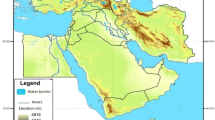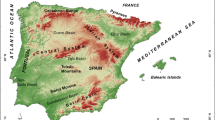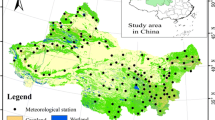Abstract
Changes in vegetation land cover are influenced by, and therefore an indicator of, climatic conditions. The aim of this study is to investigate the relationship between vegetation cover changes and drought events in a small-scale area. Six Landsat images during 1987–2019 were used to extract information about the vegetation land cover changes using the normalized difference vegetation index (NDVI) and the fractional vegetation cover (FVC) in Balqarn Governorate in the northern mountains of Asir, Saudi Arabia. Two climatic parameters, temperature and precipitation, were used as time series for the same period and were decomposed to investigate the seasonal and trend changes for each parameter. The two parameters were also used to calculate the standardized precipitation evapotranspiration index (SPEI) to conduct an in-depth analysis of the drought events influencing vegetation cover. The results showed that the state of the vegetation coverage of the study area remained at a medium level with an average NDVI value, but the FVC values showed evidence of dynamic variability associated with drought and moisture events. The SPEI showed that the study area has been undergoing a long-duration drought event since 2004, ranging from light to severe drought, which was consistent with the time series decomposition results. This investigation has revealed that drought drives changes in vegetation cover and is expressed on small geographic scales as changes in the vegetation cover structure. The framework described here is simple and can be used to evaluate and manage drought risks.









Similar content being viewed by others
References
AghaKouchak, A., Farahmand, A., Melton, F. S., Teixeira, J., Anderson, M. C., Wardlow, B. D., & Hain, C. R. (2015). Remote sensing of drought: progress, challenges and opportunities: remote sensing of drought. Reviews of Geophysics, 53(2), 452–480. https://doi.org/10.1002/2014RG000456.
Ahmad, B. (1993). Climate of the Kingdom of Saudi Arabia. Kuwait: Kuwait University https://search.mandumah.com/Download?file=5ab7slHChzxtRdY9CjC7AwrU3YksePk00ivPoo85edA=&id=255594.
Ajayi, V. O., & Ilori, O. W. (2020). Projected drought events over West Africa using RCA4 regional climate model. Earth Systems and Environment, 4(2), 329–348. https://doi.org/10.1007/s41748-020-00153-x.
Al-Aklabi, A., Al-Khulaidi, A. W., Hussain, A., & Al-Sagheer, N. (2016). Main vegetation types and plant species diversity along an altitudinal gradient of Al Baha region, Saudi Arabia. Saudi Journal of Biological Sciences, 23(6), 687–697. https://doi.org/10.1016/j.sjbs.2016.02.007.
Alghamdi, S. (2009). Effect of terrain characteristics on vegetation cover of Zahran region in Sarawat mountains: a systematic study in remote sensing and GIS. Journal of Al-Imam Muhammad Ibn Saud Islamic University, 13, 185–243.
Almazroui, M., Islam, M. N., Athar, H., Jones, P. D., & Rahman, M. A. (2012). Recent climate change in the Arabian peninsula: annual rainfall and temperature analysis of Saudi Arabia for 19782009. International Journal of Climatology, 32, 953–966.
Bhunia, P., Das, P., & Maiti, R. (2020). Meteorological drought study through SPI in three drought prone districts of West Bengal, India. Earth Systems and Environment, 4(1), 43–55. https://doi.org/10.1007/s41748-019-00137-6.
Bucchignani, E. (2018). Climate change projections for the Middle East-North Africa domain with COSMO-CLM at different spatial resolutions. Advances in Climate Change Research, 9, 66–88. https://doi.org/10.1016/j.accre.2018.01.004.
Campbell, J. B., & Wynne, R. H. (2011). Introduction to remote sensing (5th ed.). New York: Guilford Press.
Chander, G., & Markham, B. (2003). Revised landsat-5 tm radiometric calibration procedures and postcalibration dynamic ranges. IEEE Transactions on Geoscience and Remote Sensing, 41(11), 2674–2677. https://doi.org/10.1109/TGRS.2003.818464.
Chander, G., Markham, B. L., & Barsi, J. A. (2007). Revised Landsat-5 thematic mapper radiometric calibration. IEEE Geoscience and Remote Sensing Letters, 4(3), 490–494. https://doi.org/10.1109/LGRS.2007.898285.
Chavez, P. S. (1996). Image-based atmospheric corrections—revisited and improved. Photogrammetric Engineering and Remote Sensing, 62(9), 1025–1036.
Cleveland, R. B., Cleveland, W. S., McRae, J. E., & Terpenning, I. (1990). STL: a seasonal-trend decomposition procedure based on loess. Journal of Official Statistics, 6(1), 3–33.
Crausbay, S. D., Ramirez, A. R., Carter, S. L., Cross, M. S., Hall, K. R., Bathke, D. J., Betancourt, J. L., Colt, S., Cravens, A. E., Dalton, M. S., Dunham, J. B., Hay, L. E., Hayes, M. J., McEvoy, J., McNutt, C. A., Moritz, M. A., Nislow, K. H., Raheem, N., & Sanford, T. (2017). Defining ecological drought for the twenty-first century. Bulletin of the American Meteorological Society, 98(12), 2543–2651.
Dai, A. (2013). Increasing drought under global warming in observations and models. Nature Climate Change, 3(1), 52–58. https://doi.org/10.1038/nclimate1633.
Deardorff, J. W. (1978). Efficient prediction of ground surface temperature and moisture, with inclusion of a layer of vegetation. Journal of Geophysical Research, 83(C4), 1889–1903. https://doi.org/10.1029/JC083iC04p01889.
Ding, Y., Zheng, X., Zhao, K., Xin, X., & Liu, H. (2016). Quantifying the impact of NDVIsoil determination methods and NDVIsoil variability on the estimation of fractional vegetation cover in Northeast China. Remote Sensing, 8(1), 29–44. https://doi.org/10.3390/rs8010029.
Dong, L., Jiang, H., & Yang, L. (2018). Spatio-temporal change of vegetation coverage and its driving forces based on Landsat images: a case study of Changchun City. ISPRS - International Archives of the Photogrammetry, Remote Sensing and Spatial Information Sciences, XLII–3, 295–298. https://doi.org/10.5194/isprs-archives-XLII-3-295-2018.
Du, T. L. T., Bui, D. D., Nguyen, M. D., & Lee, H. (2018). Satellite-based, multi-indices for evaluation of agricultural droughts in a highly dynamic tropical catchment, Central Vietnam. Water, 10(5), 659–683. https://doi.org/10.3390/w10050659.
Getis, A., & Ord, J. K. (2010). The analysis of spatial association by use of distance statistics. Geographical Analysis, 24(3), 189–206. https://doi.org/10.1111/j.1538-4632.1992.tb00261.x.
Ghazal, A. M. F. (2015). Vegetation patterns and plant communities distribution along an altitudinal gradient at Asir mountain, Southwest Saudi Arabia. Pakistan Journal of Botany, 47(4), 1377–1389.
Gholamnia, M., Khandan, R., Bonafoni, S., & Sadeghi, A. (2019). Spatiotemporal analysis of MODIS NDVI in the Semif-arid region of Kurdistan (Iran). Remote Sensing, 11(14), 1723–1741. https://doi.org/10.3390/rs11141723.
Guan, B. T. (2014). Ensemble empirical mode decomposition for analyzing phenological responses to warming. Agricultural and Forest Meteorology, 194, 1–7. https://doi.org/10.1016/j.agrformet.2014.03.010.
Guo, L., Wu, S., Zhao, D., Yin, Y., Leng, G., & Zhang, Q. (2014). NDVI-based vegetation change in Inner Mongolia from 1982 to 2006 and its relationship to climate at the biome scale. Advances in Meteorology, 2014, 1–12. https://doi.org/10.1155/2014/692068.
Higginbottom, T. P., & Symeonakis, E. (2014). Assessing land degradation and desertification using vegetation index data: current frameworks and future directions. Remote Sensing, 6, 9552–9575. https://doi.org/10.3390/rs6109552.
Hosni, H., & Hegazy, A. (1996). Contribution to the flora of Asir, Saudi Arabia. Candollea, 51, 169–202.
Hua, L., Wang, H., Sui, H., Wardlow, B., Hayes, M. J., & Wang, J. (2019). Mapping the spatial-temporal dynamics of vegetation response lag to drought in a semi-arid region. Remote Sensing, 11(16), 1873–1895. https://doi.org/10.3390/rs11161873.
Huang, X., Zhang, T., Yi, G., He, D., Zhou, X., Li, J., Bie, X., & Miao, J. (2019). Dynamic changes of NDVI in the growing season of the Tibetan plateau during the past 17 years and its response to climate change. International Journal of Environmental Research and Public Health, 16(18), 3452–3473. https://doi.org/10.3390/ijerph16183452.
Huffman, G. J., & Bolvin, D. T. (2015). TRMM and other data precipitation data set documentation.
Ichii, K., Kawabata, A., & Yamaguchi, Y. (2002). Global correlation analysis for NDVI and climatic variables and NDVI trends: 1982-1990. International Journal of Remote Sensing, 23(18), 3873–3878. https://doi.org/10.1080/01431160110119416.
Jia, K., Li, Y., Liang, S., Wei, X., & Yao, Y. (2017). Combining estimation of green vegetation fraction in an arid region from Landsat 7 ETM+ data. Remote Sensing, 9(11), 1121–1136. https://doi.org/10.3390/rs9111121.
Jiao, W., Zhang, L., Chang, Q., Fu, D., Cen, Y., & Tong, Q. (2016). Evaluating an enhanced vegetation condition index (VCI) based on VIUPD for drought monitoring in the continental United States. Remote Sensing, 8(3), 224–245. https://doi.org/10.3390/rs8030224.
Li, B., Yu, W., & Wang, J. (2011). An analysis of vegetation change trends and their causes in Inner Mongolia, China from 1982 to 2006. Advances in Meteorology, 2011, 1–8. https://doi.org/10.1155/2011/367854.
Liu, X., Xu, Z., & Peng, D. (2019). Spatio-temporal patterns of vegetation in the Yarlung Zangbo River, China during 1998–2014. Sustainability, 11, 4334–4345. https://doi.org/10.3390/su11164334.
Ma, S., Zhou, Y., Gowda, P. H., Chen, L., Starks, P. J., Steiner, J. L., & Neel, J. P. S. (2019). Evaluating the impacts of continuous and rotational grazing on Tallgrass prairie landscape using high-spatial-resolution imagery. Agronomy, 9(5), 238–253. https://doi.org/10.3390/agronomy9050238.
Measho, S., Chen, B., Trisurat, Y., Pellikka, P., Guo, L., Arunyawat, S., Tuankrua, V., Ogbazghi, W., & Yemane, T. (2019). Spatio-temporal analysis of vegetation dynamics as a response to climate variability and drought patterns in the semiarid region, Eritrea. Remote Sensing, 11(6), 724–747. https://doi.org/10.3390/rs11060724.
Mitchell, A. (2009). The ESRI guide to GIS analysis - volume 1: Geographic patterns & relationships. Redlands, California: ESRI Press.
Na, Y., Bao, S., Hashimoto, K., McCarthy, C., & Hoshino, B. (2018). The effects of grazing systems on plant communities in steppe lands: a case study from Mongolia’s pastoralists and inner Mongolian settlement areas. Land, 7(1), 10–20. https://doi.org/10.3390/land7010010.
Nasrallah, A., Baghdadi, N., El Hajj, M., Darwish, T., Belhouchette, H., Faour, G., et al. (2019). Sentinel-1 data for winter wheat phenology monitoring and mapping. Remote Sensing, 11(19), 2228–2257. https://doi.org/10.3390/rs11192228.
Na-U-Dom, T., Mo, X., & Garcίa, M. (2017). Assessing the climatic effects on vegetation dynamics in the Mekong River basin. Environments, 4(1), 17–32. https://doi.org/10.3390/environments4010017.
Nemani, R. R. (2003). Climate-driven increases in global terrestrial net primary production from 1982 to 1999. Science, 300(5625), 1560–1563. https://doi.org/10.1126/science.1082750.
Ord, J. K., & Getis, A. (2010). Local spatial autocorrelation statistics: distributional issues and an application. Geographical Analysis, 27(4), 286–306. https://doi.org/10.1111/j.1538-4632.1995.tb00912.x.
Paolini, L., Grings, F., Sobrino, J. A., Jiménez Muñoz, J. C., & Karszenbaum, H. (2006). Radiometric correction effects in Landsat multi-date/multi-sensor change detection studies. International Journal of Remote Sensing, 27(4), 685–704. https://doi.org/10.1080/01431160500183057.
Patlakas, P., Stathopoulos, C., Flocas, H., Kalogeri, C., & Kallos, G. (2019). Regional climatic features of the Arabian Peninsula. Atmosphere, 10, 220–252. https://doi.org/10.3390/atmos10040220.
Piao, S., Wang, X., Ciais, P., Zhu, B., Wang, T., & Liu, J. (2011). Changes in satellite-derived vegetation growth trend in temperate and boreal Eurasia from 1982 to 2006: change in vegetation growth over Eurasia. Global Change Biology, 17(10), 3228–3239. https://doi.org/10.1111/j.1365-2486.2011.02419.x.
Poděbradská, W., Hayes, W., Bathke, B., & Dahal. (2019). Monitoring drought impact on annual forage production in semi-arid grasslands: a case study of Nebraska Sandhills. Remote Sensing, 11(18), 2106–2131. https://doi.org/10.3390/rs11182106.
Quenum, G. M. L. D., Klutse, N. A. B., Dieng, D., Laux, P., Arnault, J., & Kodja, Japhet. D., & Oguntunde, P. G. (2019). Identification of potential drought areas in West Africa under climate change and variability. Earth Systems and Environment, 3(3), 429–444. https://doi.org/10.1007/s41748-019-00133-w.
Roerink, G. J., Menenti, M., Soepboer, W., & Su, Z. (2003). Assessment of climate impact on vegetation dynamics by using remote sensing. Physics and Chemistry of the Earth, Parts A/B/C, 28(1–3), 103–109. https://doi.org/10.1016/S1474-7065(03)00011-1.
Rouse, J. W., Haas, R. H., Schell, J. A., Deering, D. W., & Harlen, J. (1974). Monitoring the vernal advancement and retrograduation (Green wave effect) of natural vegetation (type III final report) (p. 390). Greenbelt: NASA Godard Space Flight Center.
Roy, D. P., Wulder, M. A., Loveland, T. R., Woodcock, C. E., Allen, R. G., Anderson, M. C., et al. (2014). Landsat-8: science and product vision for terrestrial global change research. Remote Sensing of Environment, 145, 154–172. https://doi.org/10.1016/j.rse.2014.02.001.
Seraj, S. S., Jrais, R. N., & Ayyad, S. K. (2014). Floristic composition, life form and chorology of plant life at Al-Saoda, Asir region, South-Western Saudi Arabia. Journal of Biology, Agriculture and Healthcare, 4(26), 60–67.
Snyder, K. A., Evers, L., Chambers, J. C., Dunham, J., Bradford, J. B., & Loik, M. E. (2019). Effects of changing climate on the hydrological cycle in Cold Desert ecosystems of the Great Basin and Columbia plateau. Rangeland Ecology & Management, 72(1), 1–12. https://doi.org/10.1016/j.rama.2018.07.007.
Solomon, S., Intergovernmental Panel on Climate Change, & Intergovernmental Panel on Climate Change (Eds.). (2007). Climate change 2007: the physical science basis: contribution of Working Group I to the Fourth Assessment Report of the Intergovernmental Panel on Climate Change. Cambridge: Cambridge University Press.
Spinoni, J., Barbosa, P., Bucchignani, E., Cassano, J., Cavazos, T., Christensen, J. H., Christensen, O. B., Coppola, E., Evans, J., Geyer, B., Giorgi, F., Hadjinicolaou, P., Jacob, D., Katzfey, J., Koenigk, T., Laprise, R., Lennard, C. J., Kurnaz, M. L., Li, D., Llopart, M., McCormick, N., Naumann, G., Nikulin, G., Ozturk, T., Panitz, H. J., Porfirio da Rocha, R., Rockel, B., Solman, S. A., Syktus, J., Tangang, F., Teichmann, C., Vautard, R., Vogt, J. V., Winger, K., Zittis, G., & Dosio, A. (2020). Future global meteorological drought hot spots: a study based on CORDEX data. Journal of Climate, 33(9), 3635–3661. https://doi.org/10.1175/JCLI-D-19-0084.1.
Svobodová, K., Langbehn, T., Björklund, J., Rydval, M., Trotsiuk, V., Morrissey, R. C., Čada, V., Janda, P., Begovič, K., Ágh-Lábusová, J., Schurman, J. S., Nováková, M., Kozák, D., Kameniar, O., Synek, M., Mikoláš, M., & Svoboda, M. (2019). Increased sensitivity to drought across successional stages in natural Norway spruce (Picea abies (L.) karst.) forests of the Calimani Mountains, Romania. Trees, 33(5), 1345–1359. https://doi.org/10.1007/s00468-019-01862-1.
Tarawneh, Q. Y. (2013). Quantification of drought in the Kingdom of Saudi Arabia. In 5 International Conference on Water Resources and Arid Environments (ICWRAE 5) (pp. 425–433). Presented at the 5 international conference on water resources and arid environments (ICWRAE 5), Riyadh: ICWREA.
Thornthwaite, C. W. (1948). An approach toward a rational classification of climate. Geographical Review, 38(1), 55–94.
Tong, S., Te, R., Ma, Q., Ha, S., & Lusi, A. (2017). Analysis of drought characteristics in Xilingol grassland of northern China based on SPEI and its impact on vegetation. Mathematical Problems in Engineering, 2017, 1–12. https://doi.org/10.1155/2017/5209173.
Trisurat, Y., Shirakawa, H., & Johnston, J. (2019). Land-use/land-cover change from socio-economic drivers and their impact on biodiversity in Nan Province, Thailand. Sustainability, 11(3), 649–671. https://doi.org/10.3390/su11030649.
Tutubalina, O. V., & Rees, W. G. (2001). Vegetation degradation in a permafrost region as seen from space: Noril’sk (1961–1999). Cold Regions Science and Technology, 32(2–3), 191–203. https://doi.org/10.1016/S0165-232X(01)00049-0.
UNCCD. (1994). United Nations convention to combat desertification in those countries experiencing serious drought and/or desertification, particularly in Africa. (international convention no. Ch_XXVII_10) (p. 422). Paris: United Nations.
USGS. (2016). Landsat 8 (L8) data users handbook (4th ed.). Sioux Falls: Earth resources observation and science (EROS) center.
Vicente-Serrano, S. M., Beguería, S., Lorenzo-Lacruz, J., Camarero, J. J., López-Moreno, J. I., Azorin-Molina, C., Revuelto, J., Morán-Tejeda, E., & Sanchez-Lorenzo, A. (2012). Performance of drought indices for ecological, agricultural, and hydrological applications. Earth Interactions, 16(10), 1–27. https://doi.org/10.1175/2012EI000434.1.
Vicente-Serrano, S. M., Begueria, S., & Pez-Moreno, J. I. L. (2010). A multiscalar drought index sensitive to global warming: the standardized precipitation evapotranspiration index. Journal of Climate, 23, 1696–1718. https://doi.org/10.1175/2009JCLI2909.1.
Wei, F., Wang, S., Fu, B., Pan, N., Feng, X., Zhao, W., & Wang, C. (2018). Vegetation dynamic trends and the main drivers detected using the ensemble empirical mode decomposition method in East Africa. Land Degradation & Development, 29(8), 2542–2553. https://doi.org/10.1002/ldr.3017.
Wulder, M. A., Loveland, T. R., Roy, D. P., Crawford, C. J., Masek, J. G., Woodcock, C. E., Allen, R. G., Anderson, M. C., Belward, A. S., Cohen, W. B., Dwyer, J., Erb, A., Gao, F., Griffiths, P., Helder, D., Hermosilla, T., Hipple, J. D., Hostert, P., Hughes, M. J., Huntington, J., Johnson, D. M., Kennedy, R., Kilic, A., Li, Z., Lymburner, L., McCorkel, J., Pahlevan, N., Scambos, T. A., Schaaf, C., Schott, J. R., Sheng, Y., Storey, J., Vermote, E., Vogelmann, J., White, J. C., Wynne, R. H., & Zhu, Z. (2019). Current status of Landsat program, science, and applications. Remote Sensing of Environment, 225, 127–147. https://doi.org/10.1016/j.rse.2019.02.015.
Xie, Y., Sha, Z., & Yu, M. (2008). Remote sensing imagery in vegetation mapping: a review. Journal of Plant Ecology, 1(1), 9–23. https://doi.org/10.1093/jpe/rtm005.
Xu, H., Wang, X., & Yang, T. (2017). Trend shifts in satellite-derived vegetation growth in Central Eurasia, 1982–2013. Science of the Total Environment, 579, 1658–1674. https://doi.org/10.1016/j.scitotenv.2016.11.182.
Xu, X., Liu, H., Lin, Z., Jiao, F., & Gong, H. (2019). Relationship of abrupt vegetation change to climate change and ecological engineering with multi-timescale analysis in the karst region, Southwest China. Remote Sensing, 11(13), 1564–1586. https://doi.org/10.3390/rs11131564.
Xue, Y., Zhang, B., He, C., & Shao, R. (2019). Detecting vegetation variations and main drivers over the Agropastoral Ecotone of northern China through the ensemble empirical mode decomposition method. Remote Sensing, 11(16), 1860–1883. https://doi.org/10.3390/rs11161860.
Yihdego, Y., Vaheddoost, B., & Al-Weshah, R. A. (2019). Drought indices and indicators revisited. Arabian Journal of Geosciences, 12(3), 69. https://doi.org/10.1007/s12517-019-4237-z.
Zhang, S., Li, Z., Lin, X., & Zhang, C. (2019). Assessment of climate change and associated vegetation cover change on watershed-scale runoff and sediment yield. Water, 11(7), 1373–1393. https://doi.org/10.3390/w11071373.
Zhao, W., Zhao, X., Zhou, T., Wu, D., Tang, B., & Wei, H. (2017). Climatic factors driving vegetation declines in the 2005 and 2010 Amazon droughts. PLoS One, 12(4), e0175379. https://doi.org/10.1371/journal.pone.0175379.
Author information
Authors and Affiliations
Corresponding author
Additional information
Publisher’s note
Springer Nature remains neutral with regard to jurisdictional claims in published maps and institutional affiliations.
Rights and permissions
About this article
Cite this article
Mohammed, W.E., Algarni, S. A remote sensing study of spatiotemporal variations in drought conditions in northern Asir, Saudi Arabia. Environ Monit Assess 192, 784 (2020). https://doi.org/10.1007/s10661-020-08771-8
Received:
Accepted:
Published:
DOI: https://doi.org/10.1007/s10661-020-08771-8




